The Egyptians had to construct ramps and pull the blocks up with ropes and brute force. But the Greeks invented the lifting tongs, the block and tackle, and this ingenious wedge device:
the Holivela
Holivela
Most people have never seen one of these. And they wouldn’t know what to do with it if they had. Greek engineers invented it about the same time (200-300 BC) as they invented the Archimedes screw and the Ctesibius pump, though it bears no one’s name. The Romans called it a holivela. It is used to lift big building blocks—or rather, to GRAB HOLD of them. The lifting itself was done with wooden beams and a block and tackle.
How does the holivela work?
The stonecutter carves a small, rectangular hole in the middle of the stone block. The hole is just wide enough for the holivela to fit with all its pieces.
When he is ready to lift the block with his crane, he drops the holivela into the hole. He pulls out the pin that runs through all the pieces and adds a “slice” of iron, or removes one, until the fit is right. Then he puts the pin back in, ties the lifting rope to the holivela, and tells the crane operator to lift.
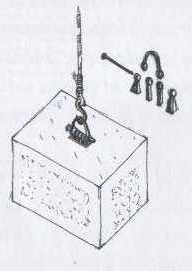 Drawing showing how the holivela was used
Drawing showing how the holivela was used
As the rope tightens, those wedge-shaped end pieces of the holivela push outward. The greater the weight of the stone, the greater the sideways thrust. The holivela wedges itself very tightly in the hole and can be counted on not to let the block go.
The crane carefully lowers the block into place on the wall.
Then the stone-cutter comes and removes the holivela. How? He simply pulls out the pin at the top, which relaxes the whole series of slices and wedged-shaped ends. They come out easily.
Renaissance builders used the holivela a lot in buildings, like the Escorial, King Philip’s monastery palace in Spain.
The advantage of the little rectangular hole in the middle of the stone is that it will be covered up by the block above it and be invisible. The disadvantage is that the hole weakens the block.
The other block-grabbing device, the lifting tongs, was a fine invention too and they are still used.
Tongs lifting a stone block
Modern lifting tongs
The tongs press tighter the greater the load. But they have a big drawback too: the little holes you drill in the side of the block for the claws don’t go away and remain visible forever.
See the holes for the Roman tongs in the two-thousand-year-old granite blocks of the aqueduct of Segovia, Spain
Nowadays there are big tongs that press hard enough to make the holes unnecessary.
..

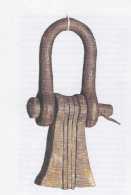

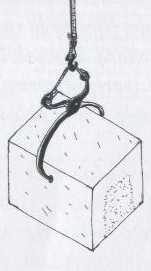
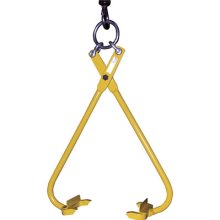
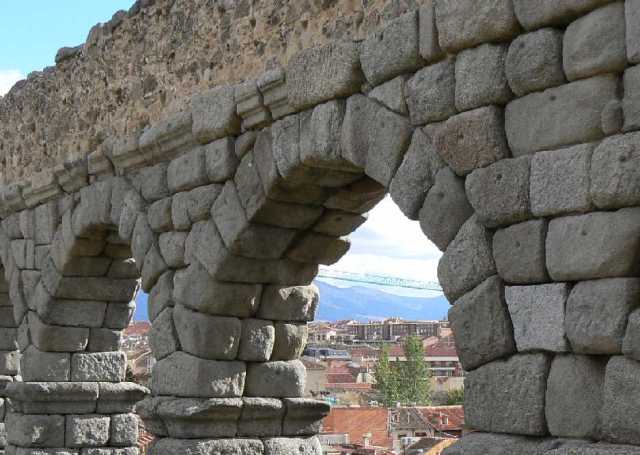
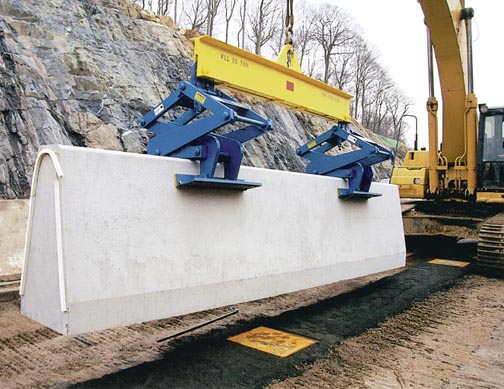


Peter Prillinger: Your comment made me go back and look at the old post. You have a point. I hadn’t realized that the hole in the stone for the holivela would have had to be shaped (tapered) to accommodate the end-pieces. You generated my thought-process too and I thank you.
I found it most interesting. However given the Holivela shown, there is nothing that
makes the outer tapered pieces spread out when raised up. Therefore it is
presumed the hole in the stone is tapered ( wider at the bottom ). Then by adding
parallel pieces in the center between the tapered pieces for a close fit allows the Holivela
to jam when raised. After lifting it may be given a tap downwards and the pin release to remove all.
I note there was a later Holivela design that provide a spreading action between the outer
tapered pieces. Then came Tongs etc.
Thanks for generating the thought process as to how the very heavy blocks of stone were
raise into place. This lead me to learn about Ctesibius and his many inventions. Made My Day.
Pingback: Great Roman Engineering | Great Names in History
Still one of my favorites! Please keep your wonderful job! And thanks again! I teach Classics in Middle School, in Colombia, and your blog is very useful to motivate my students.